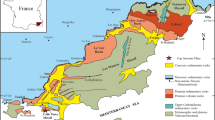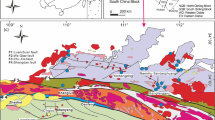Abstract
The paper presents materials on the fabric of the western, southwestern, and southern exocontact zones of the Khibina alkaline pluton and metavolcanic rocks of the Il’mozerskaya Formation of the Paleoproterozoic Imandra-Varzuga riftogenic structure. The volcanics of the Imandra-Varzuga structure were originally metamorphosed to the greenschist facies (at temperatures of ≥300°C and pressures of ≥2.0–2.5 kbar) and were afterward metamorphosed to the pyroxene-hornfels facies under the thermal effect the Khibina pluton with the development of a hornfels zone 150–400 m thick. According to their composition, the hornfelses are subdivided into three zones: inner, intermediate, and outer. The inner zone is up to 30 m thick and consists of hornfelses of clinopyroxene-plagioclase composition with olivine as a typomorphic mineral and with variable amounts of amphibole. The intermediate zone occurs at a distance of 30–200 m from the pluton, is separated from the inner zone by the olivine isograde, and consists of amphibole-clinopyroxene-plagioclase hornfelses. The outer zone, 200–400 m away from the contact of the pluton, is made of fine-grained melanocratic hornblende hornfelses. The thermal transformations of the metavolcanics involved the gradual replacement of their low-temperature mineral assemblage (actinolite + albite) by a higher temperature one (clinopyroxene + amphibole + andesinebytownite ± olivine). Our data on the chemical composition of the rock-forming minerals of the hornfelses indicate that the olivine is ferrohortonolite-fayalite, the clinopyroxene belongs to the augite-ferroaugite series, and occasional orthopyroxene grains (which were found only in the intermediate zone) are ferrohypersthene. The amphibole in the hornfelses of the intermediate zone and the outermost (farthest from the contact) part of the inner zone is edenite, a Ca amphibole. The amphibole in hornfelses near the contact is kataphorite of the Na-Ca amphibole group. The plagioclase composition generally corresponds to andesine and bytownite and is albite-oligoclase near the contact with the pluton. The hornfelses adjacent to the contact bear rare sanidine grains. The mineral thermo-and barometry of the hornfelses yielded temperatures of 700–640°C and pressures of 1–1.5 kbar. The temperature determined for the zone exactly at the contact was approximately 700°C, which corresponds to the initial temperature of the rocks in contact with the magma and is close to the crystallization temperature of the nepheline syenites of the Khibina pluton.
Similar content being viewed by others
References
U. Kramm, L. N. Kogarko, V. A. Kononova, and H. Vartiainen, “The Kola Alkaline Province of the CIS and Finland: Precise Rb-Sr Ages Define 380–360 Ma Age Range for All Magmatism,” Lithos 30, 33–44 (1993).
V. N. Gorstka, Contact Zone of the Khibiny Alkaline Massif (Nauka, Leningrad, 1971) [in Russian].
Imandra-Varzuga Zone of the Karelides (Geology, Geochemistry, and Evolution), Ed. by G. I. Gorbunov (Nauka, Leningrad, 1982) [in Russian].
V. F. Smol’kin, “Magmatism of the Early Proterozoic (2.5–1.7 Ga) Rift System in the Northwestern Baltic Shield,” Petrologiya 5, 394–411 (1997) [Petrology 5, 350–365 (1997)].
T. B. Bayanova and V. V. Chashchin, “New Results of Radiological Dating of Felsic Metavolcanic Rocks of the Kislaya Guba and Seidorechka Formations,” in Proceedings of 1st All-Russia Paleovolcanological Symposium. Paleovolcanology, Volcanogenic-Sedimentary Lithogenesis, Hydrothermal Metamorphism, and Ore Formation in Precambrian, Petrozavodsk, Russia, 2001 (KarNTs RAN, Petrozavodsk, 2001), pp. 16–17 [in Russian].
V. S. Dokuchaeva, A. A. Zhangurov, and Zh. A. Fedotov, “Imandra Lopolith: A Newly Found Large Layered Intrusion at the Kola Peninsula,” Dokl. Akad. Nauk SSSR 265(5), 1231–1234 (1982).
Y. A. Balashov, T. B. Bayanova, and F. P. Mitrofanov, “Isotope Data on the Age and Genesis of Layered Basic-Ultrabasic Intrusions in the Kola Peninsula and Northern Karelia, Northeastern Baltic Shield,” Precambrian Res. 64(1/4), 197–205 (1993).
T. B. Bayanova, N. V. Levkovich, and L. V. Ivanova, “Zircon-Baddeleyite Geochronological System in the Precambrian Rocks of the Kola Region,” in Proceedings of 9th Youth Conference on the Geology of the Baltic Shield and Other Precambrian Areas in Russia, Apatity, Russia, 1995 (KNTs RAN, Apatity, 1995), pp. 25–29 [in Russian].
Yu. V. Amelin, L. M. Heaman, and V. S. Semenov, “U-Pb Geochronology of Layered Mafic Intrusions in the Eastern Baltic Shield: Implications for the Timing and Duration of Paleoproterozoic Continental Rifting,” Precambrian Res. 75, 31–46 (1995).
R. M. Galimzyanova, F. P. Mitrofanov, T. B. Bayanova, et al. “Origin and U-Pb Age of Granophyres of the Imandra Differentiated Intrusion, Kola Region,” Dokl. Akad. Nauk 363, 805–807 (1998) [Dokl. Earth Sci. 363, 1301–1303 (1998)].
T. B. Bayanova, R. M. Galinzyanova, and G. A. Fedotov, “Evidence of the Multiphase Complex History of the Imandra Lopolith,” in Proceedings of 6th Workshop of Svekalapko, Europrobe project, Lammi, Finland, 2001 (Oulu Univ., 2001).
I. D. Batieva, I. V. Bel’kov, M. P. Kravchenko, et al., “Age of the Soustav Alkaline Massif at the Kola Peninsula,” Dokl. Akad. Nauk SSSR 270(4), 931–933 (1983).
A. A. Arzamastsev, F. Bea, L. V. Arzamastseva, and P. Montero, “Proterozoic Soustov Intrusion, Kola Peninsula: Model of the Formation of Alkaline Magmas with Anomalous Sr-Nd Isotope Characteristic due to Crust-Mantle Interaction,” in Transactions of Scientific School “Alkaline Magmatism of the Earth (GEOKhI RAN, Moscow, 2001), pp. 10–11 [in Russian].
I. S. Ozhinskii, “On the Geology of Western Contact of the Khibiny Alkaline Massif,” Izv. Leningradsk. Geol. Tr., No. 3 (1936).
S. I. Zak, “Contact-Metasomatic Alterations near the Contact of the Khibiny Alkaline Massif,” in Magmatism and Geology of the Kola Peninsula (Kol’sk. Fil. AN SSSR, Apatity, 1963), pp. 45–55 [in Russian].
Khibiny Alkaline Massif, Ed. by N. A. Volotovskaya (Nedra, Leningrad, 1972) [in Russian].
G. T. R. Droop, “A General Equation for Estimating Fe3+ Concentrations in Ferromagnesian Silicates and Oxides from Microprobe Analyses, Using Stoichiometric Criteria,” Mineral. Mag. 51, 431–435 (1987).
B. E. Leake, A. R. Wooley, C. E. S. Arps, et al., “Nomenclature of Amphiboles. Report of the Subcommittee on Amphiboles of the International Mineralogical Association Commission on New Minerals and Mineral Names,” Eur. J. Mineral. 9(3), 623–651 (1997).
R. Kretz, “Symbols for Rock Forming Minerals,” Am. Mineral. 68, 277–279 (1983).
L. P. Bondarenko and V. B. Dagelaiskii, Geology and Metamorphism of Archean Rocks in the Central Part of the Kola Peninsula (Nauka, Leningrad, 1968) [in Russian].
E. C. Simmons, D. H. Lindsley, and J. J. Papike, “Phase Relations and Crystallization Sequence in a Contact-Metamorphosed Rocks from the Gunflint Iron Formation, Minnesota,” J. Petrol. 15(3), 539–564 (1974).
D. T. Vaniman, J. J. Papike, and T. Labotka, “Contact Metamorphic Effect of the Stillwater Complex, Montana: the Concordant Iron Formation,” Am. Mineral. 65(11/12), 1087–1102 (1980).
M. J. Gole and C. Klein, “High Grade Metamorphic Archean Banded Iron Formations, Western Australia: Assemblages with Coexisting Pyroxenes + Fayalite,” Am. Mineral. 66(1/2), 87–99 (1981).
C. S. Haase, “Metamorphic Petrology of Negaunee Iron Formation, Marquette District, Northern Michigan: Mineralogy, Metamorphic Reactions, and Phase Equilibria,” Econom. Geol. 77, 60–81 (1982).
V. V. Reverdatto, Facies of Contact Metamorphism (Nedra, Leningrad, 1970) [in Russian].
C. Russ-Nabelek, “Isochemical Contact Metamorphism of Mafic Schist, Laramie Anorthosite Complex, Wyoming: Amphibole Compositions and Reactions,” Am. Mineral. 74, 530–548 (1989).
R. J. Tracy and B. R. Frost, “Phase Equilibria and Thermobarometry of Calcareous, Ultramafic and Mafic Rocks, and Iron Formations,” in Contact Metamorphism, Ed. D. M. Kerrick, Rev. Mineral. 26, 207–290 (1991).
N. L. Dobretsov, Yu. N. Kochkin, A. P. Krivenko, and V. A. Kutolin, Rock-forming Pyroxenes (Nauka, Moscow, 1971) [in Russian].
V. I. Fonarev, Mineral Equilibria in Precambrian Iron Formations: Experimental, Thermodynamic, and Petrological Data (Nauka, Moscow, 1987) [in Russian].
L. L. Perchuk, Equilibria of Rock-Forming Minerals (Nauka, Moscow, 1970) [in Russian].
W. G. Ernst and J. Liu, “Experimental Phase-Equilibrium Study of Al and Ti Contents of Calcic Amphibole in MORB—A Semiquantitative Thermobarometer,” Am. Mineral. 83, 952–969 (1998).
A. V. Galakhov, Petrology of the Khibimy Alkaline Massif (Nauka, Leningrad, 1975) [in Russian].
G. N. Shablinskii, “Problem of Deep-Seated Structure of the Khibiny and Lovozero Plutons,” Tr. Leningrad. O-va Ispyt. Prir. 74(1), (1963).
A. A. Arzamastsev, L. V. Arzamastseva, V. N. Glaznev, and A. B. Raevskii, “Petrologic-Geophysical Model for the Structure and Composition of Deep Levels of the Khibina and Lovozero Complexes, Kola Peninsula,” Petrologiya 6, 478–496 (1998) [Petrology 6, 434–450 (1998)].
L. N. Kogarko, Problems of Genesis of Agpaitic Magmas (Nedra, Moscow, 1977) [in Russian].
F. S. Spear, “An Experimental Study of Hornblende Stability and Compositional Variability in Amphibolite,” Am. J. Sci. 281, 697–734 (1981).
R. K. Popp, M. C. Gilbert, and J. R. Craig, “Stability of Mg-Fe Amphiboles with Respect to Oxygen Fugacity,” Am. Mineral. 62, 1–12 (1977).
T. Miyano and C. Klein, “Phase Relations of Orthopyroxene, Olivine and Grunerite in the High-Grade Metamorphic Iron-Formation,” Am. Mineral. 68, 699–716 (1983).
G. W. Bergantz, “Physical and Chemical Characterization of Plutons,” in Contact Metamorphism, Ed. by D. M. Kerrick, Rev. Mineral. 26, 13–42 (1991).
T. Yu. Bazarova, Thermodynamic Conditions of the Formation of Some Nepheline-bearing Rocks (Nauka, Moscow, 1969) [in Russian].
L. N. Kogarko and B. P. Romanchev, “Temperature, Pressure, and Redox Conditions of Mineral Equilibria of Agpaitic Nepheline Syenites and Apatite-Nepheline Rocks,” Geokhimiya, No. 2, 199–216 (1977).
G. L. Millhollen, “Melting of Nepheline Syenite with H2O + CO2, and the Effect of Dilution of the Aqueous Phase on the Beginning of Melting,” Am. J. Sci. 270, 244–254 (1971).
Author information
Authors and Affiliations
Additional information
Original Russian Text © V.V. Chashchin, 2007, published in Geokhimiya, 2007, No. 1, pp. 19–37.
Rights and permissions
About this article
Cite this article
Chashchin, V.V. Mineral assemblages and genesis of hornfelses in the outer contact zone of the Khibina Massif, Kola Peninsula, Russia. Geochem. Int. 45, 15–31 (2007). https://doi.org/10.1134/S0016702907010028
Received:
Issue Date:
DOI: https://doi.org/10.1134/S0016702907010028




